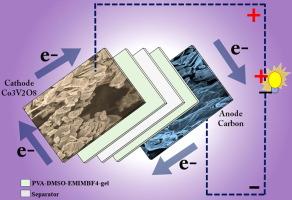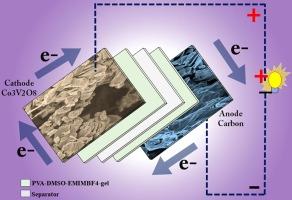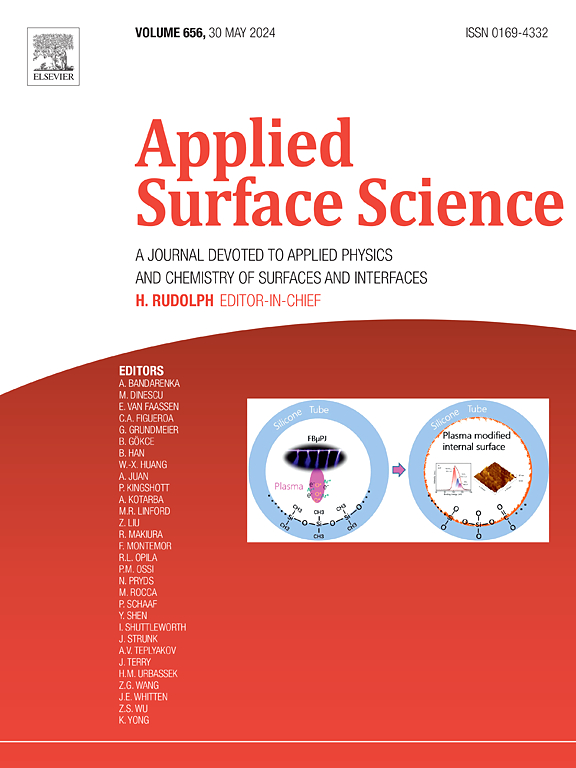微波辅助钒插值钴-MOF 阴极与离子液体凝胶聚合物电解质组装 3 V 高性能不对称超级电容器
IF 6.3
2区 材料科学
Q2 CHEMISTRY, PHYSICAL
引用次数: 0
摘要
为了改善能量存储和转换、金属协同作用和结构稳定性,双金属组装金属有机框架(MOFs)得到了深入研究。基于 MOF 的分层氧化物结构具有增大表面积、伪电容以及改变 MOF 结构的能力等特点,这引起了人们的兴趣。简单的微波和水热技术使用二甲基甲酰胺和水作为溶剂和退火方法,生成了双金属有机框架的 Co3V2O8 和 Co3VO4 阴极材料。这些定制的形状增加了氧化还原位点,减少了离子电子距离。由于钴的法拉第过程和钒的高分层属性,超级电容器电极的响应非常显著。Co3V2O8 在 2 mV/s 扫描速率下的比电容为 1391F/g,在 4 mA/cm2 实施电流值下的比电容为 1309F/g。经过 10,000 次循环后,阴极材料的容量保持率为 89%,库仑效率为 98%。生物废料衍生活性炭与 Co3V2O8 阴极相结合,用于非对称超级电容器存储。该装置使用离子液体凝胶聚合物电解质在 3 V 窗口工作。该装置的最大比能量为 329.3 Wh/kg,比功率为 15250 W/kg,在 9 mA/cm2 电流下的电容为 263.5F/g 和 220 mAh/g,并在 10,000 次循环后显示出 88.5% 的电位稳定性。这些发现证实了其作为超级电容器阴极的用途。本文章由计算机程序翻译,如有差异,请以英文原文为准。


Microwave-assisted vanadium interpolated cobalt-MOF cathode assembled 3 V high performing asymmetric supercapacitor with ionic liquid gel polymer electrolyte
To ameliorate energy storage and conversion, metal synergy, and structural stability, bimetal-assembled metal–organic frameworks (MOFs) are delved into. Augmented surface area, pseudo capacitance, and the ability to alter the MOF edifice of layered oxide have drawn interest in MOF-based oxide layered structures. Simple microwave and hydrothermal techniques use dimethyl formamide and water as solvents and annealing methods to generate the bimetallic organic framework’s Co3V2O8 and Co3VO4 cathode material. Those customized shapes boost redox sites and reduce ion electron distance. Due to cobalt’s faradaic process and vanadium’s highly layered attributes, supercapacitor electrode response is significant. Co3V2O8 has 1391F/g specific capacitance at 2 mV/s scan rate and 1309F/g at 4 mA/cm2 implemented current value. After 10,000 cycles, the cathode material depicts 89 % capacity retention and 98 % coulombic efficiency. Biowaste-derived activated carbon is combined with a Co3V2O8 cathode for asymmetric supercapacitor storage. That device works on 3 V windows with ionic liquid gel polymer electrolyte. With a maximum specific energy of 329.3 Wh/kg and specific power of 15250 W/kg, the achieved galvanometric capacitance is 263.5F/g and 220 mAh/g at the 9 mA/cm2 current and showed 88.5 % potential stability after 10,000 cycles. These findings corroborate its use as a supercapacitor cathode.
求助全文
通过发布文献求助,成功后即可免费获取论文全文。
去求助
来源期刊

Applied Surface Science
工程技术-材料科学:膜
CiteScore
12.50
自引率
7.50%
发文量
3393
审稿时长
67 days
期刊介绍:
Applied Surface Science covers topics contributing to a better understanding of surfaces, interfaces, nanostructures and their applications. The journal is concerned with scientific research on the atomic and molecular level of material properties determined with specific surface analytical techniques and/or computational methods, as well as the processing of such structures.
 求助内容:
求助内容: 应助结果提醒方式:
应助结果提醒方式:


